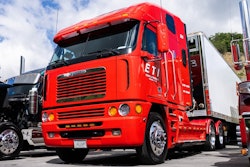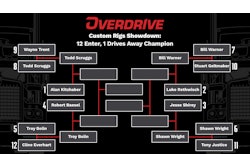By Randy Grider
Editor
[email protected]
If this year’s Mid-America Trucking Show had a theme, it would be reduced idling. Numerous press conferences at the show dealt with products and initiatives that revolve around idling reduction.
New products included an auxiliary power unit introduced by Cummins and heating and cooling units (HVAC) introduced by Dometic. Truck OEMs touched on potential plans to integrate more idle-reducing products into their units in the future.
The Department of Energy also showcased a prototype vehicle called the More Electric Truck that contains an integrated system of idle-reducing products, including an HVAC module, an APU and shore power capability among other components.
The DOE expects the More Electric Truck technology to be made available to truck OEMs and fleets in late 2005.
Reduced idling is definitely becoming a bigger factor for truckers and fleets. Several cities and states have anti-idling laws on the books and have become stricter with enforcement. Hunts Point in New York City is probably best known for its proactive stance on anti-idling.
This month’s cover story in Truckers News (page 24) examines the idling issue. It’s a complicated problem for several reasons, most obvious being the unclear path government regulators and lawmakers will take in the future. The Environmental Protection Agency has hinted at idle-free corridors, but the agency has given no definite timetable or exact details. Still, you can rest assured that with precedents being set and the cost of diesel fuel rising, the anti-idling debate will continue to grow in the coming years, and more legislation will be passed.

Which technology will be the dominating solution to address future idling concerns? Right now there are a mishmash of options that all have pros and cons. While most options offer the advantage of saving drivers and fleets money in the long run, the initial expense of idle-reduction products such as gensets and APUs is hard to sell to those living paycheck to paycheck. The good news is that if a driver or company can afford to absorb the costs upfront, they will see a return on investment usually after a couple of years.
One of the most cost-effective measures for the future may be shore power – that is if shippers, receivers and more truckstops can supply a widespread infrastructure to make it a reality. A few truckstops already offer electrification for truckers, but it’s sparse at best.
Currently, government incentives to encourage truckers, fleets and other industry players to become more proactive in reducing idling are lacking. Partnerships between fleets and government to address idling are for the most part about showing good stewardship.
But public relations moves are not enough to convince truckers to reduce idling. Truckers have a good argument that they shouldn’t be expected to freeze in the winter and roast in summer to avoid high fines. Drivers need to rest comfortably in order to properly function on the roadways.
The trucker culture itself also presents obstacles to reducing idling. Many of you have seen drivers idling their trucks in mild weather for no other reason than they have always run their engines when they are parked.
While environmental concerns may be the rallying cry of those opposed to idling, money will ultimately be the determining factor in shutting down engines. The monetary motivations will be to save on fuel and maintenance costs, avoid devastating idling fines or a combination of both.
While the trucking industry is sure to suffer more growing pangs in the anti-idling arena in the coming years, our hope is that lawmakers and regulators will take drivers’ quality of life into consideration when implementing future laws. Truckers have a lot to gain by being part of the anti-idling solution. If they are not, they’re likely to become turned off to the whole issue.









